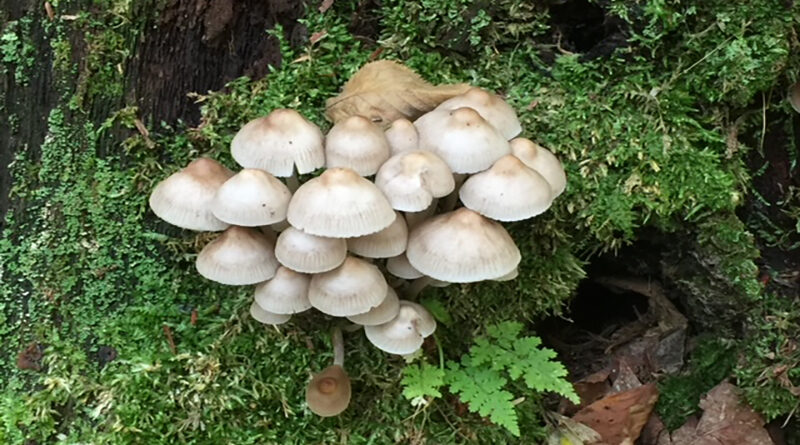Wood Wide Web
By Rick Whitteker
As the outdoor sights and sounds of summer approach, I would like to draw your attention to something fascinating that you cannot see or hear. Below the forest floor, our understanding of the silent communication between trees and fungi is unveiling a new way to look at forests.
Commonly associated with death and decay, some fungi have antibacterial properties (think penicillin), others are deadly and some have chemicals that can induce hallucinations. There is also a specific subset of fungi that attach to the tree feeder rootlets for the purpose of sharing resources. Called mycorrhizal fungi, literally meaning fungus-roots, microscopic hyphae attach to the cells of the tree roots. A mass of hyphae forms the body of fungi called mycelia. Mycelia are the fungal strands we can see spidering out under overturned logs.
This relationship between trees and mycorrhizal fungus is symbiotic and reciprocal. A tree fixes carbon in its leaves through photosynthesis and sends carbohydrates in the form of sugars to its roots. These sugars molecules are absorbed by the fungus. Like capillaries, fungal filaments fan out from the tree roots and reciprocate by sending water and nutrients back to the tree. Phosphorus, nitrogen and water are vital for tree health but can be a struggle to access without help of the extended reach of the fungus.
Like a forest community barter system, the tree provides carbon in the form of sugar in exchange for water and nutrients obtained by the fungus. This fungal network is like nature’s internet or the “Wood Wide Web,” an astounding underground communication system which is both complex and cooperative.
There is a very Canadian connection to this phrase; it was coined by Susanne Simard, a faculty of forestry at UBC and author of Finding the Mother Tree – Discover the Wisdom of the Forest. As a child raised in the temperate forests of British Columbia, Simard was enchanted by the mystery of her moss-covered playground and went on to study forestry. She is most noted for her field research related to the sharing of carbon between Douglas Fir and White Birch trees.
Simard was also able to document an extensive network of linkages under the soil with DNA micro-satellites. What she found was a series of intersecting fungal highways. The biggest, oldest trees were the most highly connected and they were termed hub trees or mother trees.
The mother trees were nurturing the young saplings in the understory at no cost to herself. Demonstrating bias towards their own offspring, mother trees send more carbon to saplings grown from her seed compared to unrelated saplings: taking care of family first!
Simard further asked the question, could a sick fir tree benefit from a healthy birch tree? Yes, it can, she found. The fir puts out warning signals that it is being attacked by some pathogen and the trees in the mycorrhizal network produce defence enzymes in preparation of insect infestation or disease. The fir will benefit from the antibiotic producing enzymes generated by the birch tree, through the mycorrhizal network. Almost like a public immunization program, without all the politics!
Recently, Simard was voted by New York Times magazine as one of the 100 “most influential people” in the world. The magazine chose Simard for her “revolutionary” finding in her extensive forest ecology research.
Like the tip of an iceberg, what you see in a forest mushroom is only a surface character in an ancient and complex underground story. Through thousands of years, a vast, hidden trading and sharing network has evolved. Not simply a collection of individual trees, this information brings a fresh perspective to consider on your forest hikes.
Submitted by Rick Whitteker. You can find Rick at home in the forest, as a seasoned trail guide, nature writer and passionate wildlife enthusiast in the Haliburton Highlands.




